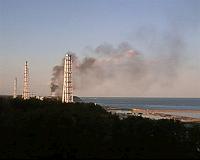| . |  |
. |
Osaka (AFP) March 25, 2011 Japan ordered the operator of a stricken nuclear plant to step up safety Friday after three workers in ill-fitting shoes suffered burns when they sloshed through highly radioactive water. The trio, aged in their 20s and 30s, were placing electric cables in a basement as part of efforts to rebuild cooling systems at the quake and tsunami damaged reactor three to prevent high-level radiation from spewing out. Two of the men, who were employed by a subcontractor, were hospitalised after suffering radiation burns from beta rays, which are powerful enough to transform a person's DNA makeup and cause potential cancer and death. The workers stepped into a pool of water containing iodine, caesium and cobalt 10,000 times the normal level, said the operator, the Tokyo Electric Power Company (TEPCO), which runs the stricken Fukushima plant. All were exposed to radiation of up to 180 millisieverts -- more than triple the usual limit for plant workers and close to the recently hiked government-imposed 250 millisievert limit for emergency duty. The news of the injured men raised pressure on the beleaguered TEPCO. Japan's nuclear safety agency has "ordered TEPCO to implement corrective measures," said agency spokesman Hideyuki Nishiyama. "If a survey of the work area had been properly carried out before, the workers could have been provided with adequate outfits. The fact that water entered raises questions about the adequacy of their outfits." Another nuclear safety agency official said that, although the men's boots were covered, "they weren't the usual long rubber boots". The top government spokesman, Chief Cabinet Secretary Yukio Edano, ordered TEPCO to "thoroughly enforce workforce management" to prevent similar mishaps. TEPCO admitted it had not thoroughly inspected the site on Thursday as it gave the go-ahead for the workers to go in, where aerial exposure was 200 millisieverts per hour, up from low levels the previous day. The radioactive water they stepped into is thought to have leaked from the damaged number three reactor -- which contains a volatile uranium-plutonium mix -- into the adjacent turbine building, the nuclear safety agency said. A TEPCO official admitted to oversight, pledging to better survey the work areas in future, share information and "work to accurately point out the things workers should be aware of." The company also said the workers had ignored the warning bell on their radiation monitors, mistakenly thinking they were broken and continuing to work 40 to 50 minutes in the toxic environment. "If the alarm goes off on workers' dosimeters, they should immediately evacuate, and if they get wet they need to immediately stop working and remove themselves from the radiation," he added. The trio brings to 17 the total number of workers who have been exposed to more than 100 millisieverts of radiation at the plant. An exposure of that amount per year is considered the lowest level at which any increase in cancer risk is evident. Some 500 workers with TEPCO, its subsidiaries as well as an army of fire-fighters and soldiers are working at the plant. The three men's injuries delayed the much-anticipated work to restore the cooling system at the number three reactor, where power had been partially restored earlier this week to the control room. It was unclear when work would resume, a TEPCO official said.
Share This Article With Planet Earth
Related Links Bringing Order To A World Of Disasters A world of storm and tempest When the Earth Quakes
 State of Japan's stricken nuclear reactors
State of Japan's stricken nuclear reactorsOsaka (AFP) March 24, 2011 Japanese emergency crews have battled to stabilise the crippled Fukushima Daiichi (No. 1) atomic power plant that has sparked global fears of a large-scale radiation disaster. The 1970s era plant was rocked by the 9.0-magnitude quake on March 11 and then hit by the 14-metre (46 foot) tsunami it triggered, cutting it off from the national electric grid and knocking out backup power systems. ... read more |
|
| The content herein, unless otherwise known to be public domain, are Copyright 1995-2010 - SpaceDaily. AFP and UPI Wire Stories are copyright Agence France-Presse and United Press International. ESA Portal Reports are copyright European Space Agency. All NASA sourced material is public domain. Additional copyrights may apply in whole or part to other bona fide parties. Advertising does not imply endorsement,agreement or approval of any opinions, statements or information provided by SpaceDaily on any Web page published or hosted by SpaceDaily. Privacy Statement |